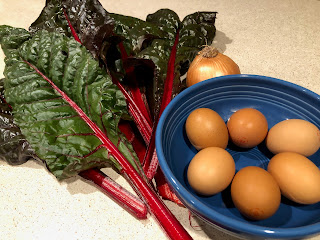
Recipe: Classic brunch dish uses this easy plant to grow and to cook

(Photos: Kathy Morrison) |

Add cheese or other veggies if you like. |
Chard and onion frittata
Serve 4-6
Ingredients :
8 stalks chard, washed thoroughly
Extra virgin olive oil
1 onion, thinly sliced
4 cloves garlic, minced
5-6 mushrooms, stemmed and sliced (optional)
Sea salt
6 eggs
Freshly ground black pepper
1/2 teaspoon dried basil, thyme or herb of your choice
Cayenne pepper (optional)
3 tablespoons grated Parmesan or other cheese
Instructions :
Remove the thick part of the stalks from the chard. Slice the leaves and tender part of the stalk no wider than about 1 inch. Chop up about half of the thicker stalk pieces, save the remainder for another project, if desired. (Pickle them, perhaps?) You should have about 6 cups of leaves and small stalk pieces.
Heat 1 tablespoon of the olive oil in a 10-inch nonstick skillet. Add the onion and saute a few minutes, until the slices begin to soften. Stir in the stalks; the onion will pick up some of the color, but that’s OK.
Once the stalks start to cook, add the mushroom slices, if using, Then add the garlic and cook another few minutes. Finally, add the chard and a pinch of salt. It will look like a lot of leaves, but don’t worry, they will shrink down plenty after a few minutes. Continue cooking until all the leaves are wilted. Remove from heat and let cool while you prepare the eggs.

Crack all the eggs into a large bowl, then add 1/8 teaspoon salt, 2 teaspoons of olive oil, some grinds of black pepper, the 1/2 teaspoon (or more) of herbs, and, if desired, a pinch of cayenne. Beat lightly with a fork or whisk. Then stir the chard mixture into the eggs.
Preheat the broiler on the oven. Wipe out the skillet, and put it back over medium-high heat. Add 2 tablespoons olive oil and swirl it around in the pan. Once the oil starts to heat up, pour in the egg mixture. As the eggs set on the bottom, tip the pan to allow the uncooked egg to slip underneath. Continue cooking until the frittata is set but still slightly jiggly on top. Remove from heat and sprinkle the cheese over the top. Slide the pan under the broiler, watching it carefully, and remove once the cheese is melted and golden.
Slide the frittata out of the pan onto a large plate, and cut into wedges to serve. This is a great brunch dish, but can be a fine dinner with the addition of a salad and fresh bread.
Comments
0 comments have been posted.Sacramento Digs Gardening to your inbox.
Sites We Like
Garden Checklist for week of May 12
Get your gardening chores and irrigation done early in the day before temperatures rise.
* Plant, plant, plant! It’s prime planting season in the Sacramento area. Time to set out those tomato transplants along with peppers and eggplants. Pinch off any flowers on new transplants to make them concentrate on establishing roots instead of setting premature fruit.
* Direct-seed melons, cucumbers, summer squash, corn, radishes, pumpkins and annual herbs such as basil.
* Harvest cabbage, lettuce, peas and green onions. This heat will cause leafy greens and onions to flower; pick them before they bolt.
* In the flower garden, direct-seed sunflowers, cosmos, salvia, zinnias, marigolds, celosia and asters.
* Plant dahlia tubers. Other perennials to set out include verbena, coreopsis, coneflower and astilbe.
* Transplant petunias, marigolds and perennial flowers such as astilbe, columbine, coneflowers, coreopsis, dahlias, rudbeckia and verbena.
* Keep an eye out for slugs, snails, earwigs and aphids that want to dine on tender new growth.
* Feed summer bloomers with a balanced fertilizer.
* For continued bloom, cut off spent flowers on roses as well as other flowering plants.
* Got fruit trees? If you haven't already done so, thin orchard fruit such as apples, peaches, pears, pluots and plums before they grow too heavy, breaking branches or even splitting the tree. Leave the largest fruit on the branch, culling the smaller ones, and allow for 5 to 6 inches (or a hand's worth) between each fruit.
* Thin grape bunches, again leaving about 6 inches between them. For the remaining bunches, prune off the "tail" end, about the bottom third of the bunch, so that the plant's energy is concentrated in the fruit closest to the branch.
* As spring-flowering shrubs finish blooming, give them a little pruning to shape them, removing old and dead wood. Lightly trim azaleas, fuchsias and marguerites for bushier plants.
* Add mulch to the garden to help keep that precious water from evaporating. Mulch also cuts down on weeds. But don’t let it mound around the stems or trunks of trees or shrubs. Leave about a 6-inch to 1-foot circle to avoid crown rot or other problems.